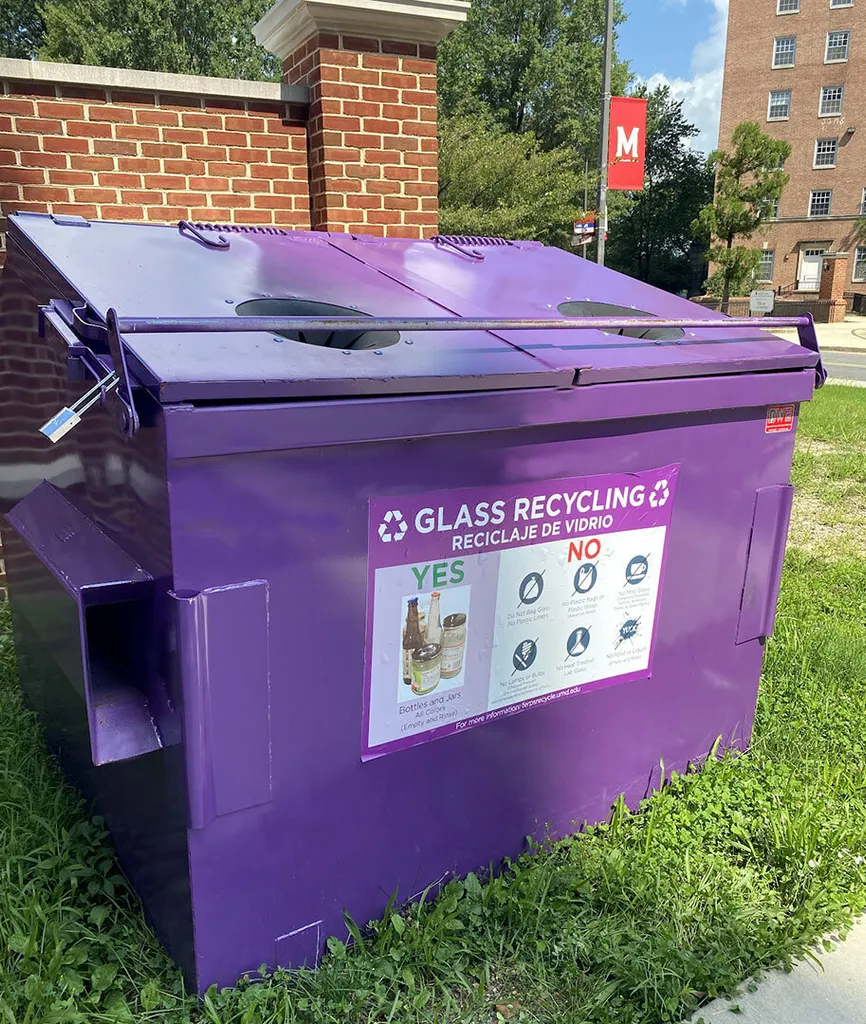- February 14, 2024
- By Maggie Haslam
Coke bottles, pickle jars and fancy yogurt containers (we’re looking at you, Yoplait) once bound for the trash now have a new destination—and will find new life—as part of University of Maryland’s efforts to expand glass recycling on campus.
Day-Glo purple glass recycling dumpsters will debut later this month alongside their familiar blue counterparts for paper, metal and plastic outside of Van Munching Hall, in the Denton community and on Fraternity Row.

“The expansion of our glass recycling is all a part of the university’s continued commitment to the state and good citizenship,” said Gabriel A. Purviance, assistant director of administrative services for Facilities Management. “We are always thinking of ways we can improve our efforts, and a priority is keeping things out of the landfill.”
Additional dumpsters will be located adjacent to the new field hockey facility to facilitate Paint Branch Creek cleanups and outside the campus’ Environmental Service Facility. A sixth new dumpster will be placed in a to-be-determined location on campus later this spring. The new dumpsters, which were funded by a 2023 Sustainability Grant, will join three existing glass recycling receptacles added to campus in 2020 as part of a pilot: in Annapolis Hall, at SECU Stadium/Gate E and outside Mulligan's at the UMD Golf Course.
The initiative adds to the campus’ efforts to boost recycling and compost efforts; in the fall, Facilities Management launched a campus-wide composting campaign to install composting bins in all campus buildings across UMD. In 2023, UMD diverted 1,275 tons of single-stream (shared bin) recycling from landfills, roughly the weight of 25 loaded semi-trucks.
Unlike traditional, flip-top or slider-door dumpsters, the glass recycling bins come with circular holes to take the guesswork out of what’s accepted. Containers should be empty and rinsed out, but paper labels and metal rings (often found on wine bottles and other beverage containers) don’t need to be pried off.
While paper, plastic, aluminum and stainless steel have long been accepted recyclables in campus recycling bins, waste management stopped allowing glass in 2019. Across many parts of the state, glass has been a notoriously difficult material to recycle since the introduction of single-stream recycling. Glass is easily broken in the recycling process; once it’s combined with other materials, it’s difficult to separate for reuse, said Adrienne Small, a recycling and solid waste coordinator for Facilities Management.
“Most people don’t know that glass cannot go in typical recycling,” she said. “But glass recycling really only works when you can isolate the product.”
According to the Environmental Protection Agency, only a fragment of glass is recycled nationwide; 7.6 million tons end up in landfills annually, shortening the facilities’ lifespans because of the complex logistics and economics behind glass recycling.
Glass collected for recycling on campus is mixed with other municipal glass and eventually distributed to a glass processing facility to be repurposed into sand and stone alternative for sandbags, landscape drainage and road construction.
“We’ve seen a real desire and enthusiasm around our sustainability initiatives by our community,” said Purviance. “Our hope is that it creates the muscle memory that they will take forward when they leave Maryland.”
Not all glass is created equal. Here’s what types of products can go into UMD’s purple bins—and what you should send to the landfill:
RECYCLE: Empty, rinsed glass bottles and jars or all colors, unbagged. Their paper labels and metal caps and lids can be included.
TOSS: Lamps or bulbs (which CAN be disposed of through Environmental Safety), lab glass and miscellaneous glass like Pyrex containers, windows, ceramics and mirrors.
Learn more at recycle.umd.edu.
Topics
Campus & CommunityUnits
Facilities Management